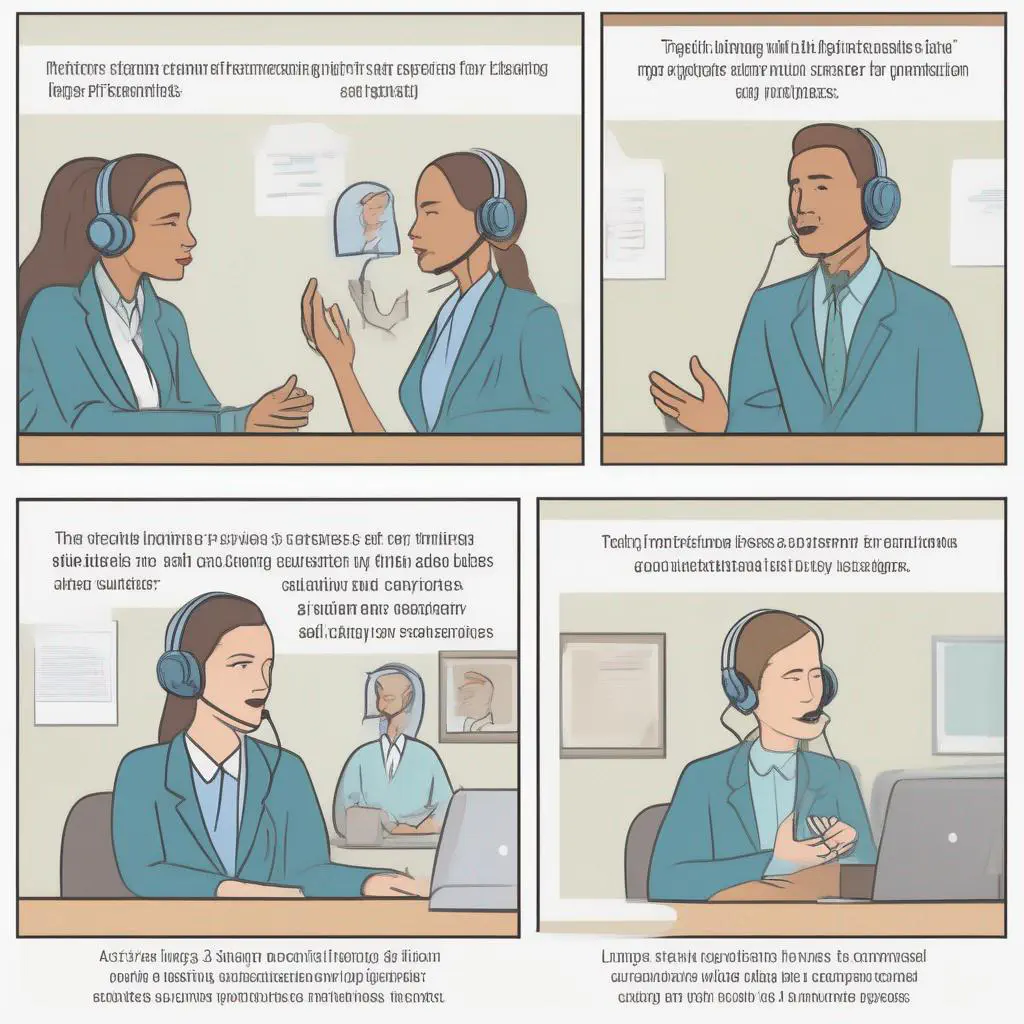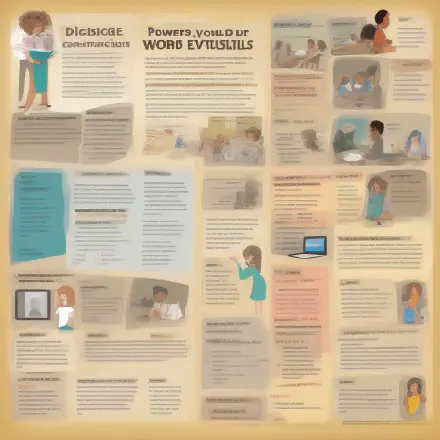
’''
I. Introduction
Active listening, as a vital communication tool, plays a significant role in virtually every aspect of life including personal relationships, work settings, and customer service environments. In particular, the customer service space has evolved to a point where mere passive hearing is no longer sufficient to meet the dynamic needs, expectations, and sentiments of customers. To stand out as a customer service representative in today’s competitive business environment, it is paramount to master the art of active listening.
Active listening is not just about lending an ear to what the customer is saying, it involves truly understanding the messages that the customer is trying to convey and empathizing with their feelings. It also means being fully engaged in the dialogue and responding appropriately without rushing to conclusions. This is the essence of quality customer service as it enables you to deeply understand a customer’s problem, respond to it effectively, and ultimately deliver a satisfying resolution that creates loyal customers.
In the forthcoming sections, this article will explore the definition of active listening and why it is crucial in customer service. We’ll then delve into both basic and advanced active listening techniques that can improve the quality of a service. Further, we will discuss the benefits of active listening and present actionable steps for implementing such techniques in your customer service practice. We will also highlight common mistakes to avoid while practicing active listening. By the end of this read, our intent is to equip you with practical tools to enhance your communication skills in the customer service field and boost customer satisfaction.
Will learning and applying these active listening techniques guarantee a 100% success rate in satisfying customers? Absolutely not. People are different, and their needs can evolve over time. However, honing these skills will undeniably increase your chances of making customers feel valued and cared for, and after all, these are among the most critical factors that determine the overall customer experience.
With this note, let’s unfold the information and insights packed in this resource to help you foster a closer connection with your customers, resolve their problems effectively, and ultimately, establish an excellent customer service reputation for your organization. ’''
II. What is Active Listening?
Active listening is a communication technique, often used in interpersonal communication, where an individual not only fully focuses on the speaker but also shows their understanding and engagement by responding and providing relevant feedback. Unlike passive listening, where an individual only receives the information, active listening involves a level of understanding and interpreting the message in order to form a substantial response. It is much more than just ‘hearing’ the words that are being communicated.
A. Definition of Active Listening
“Active Listening is an intentional focus on who you are listening to, in order to understand what he or she is saying and to understand how the speaker is affected by the words they are communicating.”
This definition underscores that active listening is more than a physical act of hearing. It also requires emotional attentiveness to comprehend the speaker’s feelings being communicated directly or indirectly.
B. Role and Significance of Active Listening in Customer Service
In the realm of customer service, active listening is of pivotal importance. It helps the customer service representatives to understand the needs and concerns of customers explicitly and implicitly. By practicing active listening, customer service representatives can decipher the spoken and unspoken customer’s needs, enabling effective problem resolution.
Moreover, active listening in customer service transcends offering solutions to customers’ problems. It also involves validating customers’ feelings and experiences, reducing their stress, and even turning an unfortunate situation into a positive customer experience. Here’s a breakdown:
- Understanding needs: Active listening enables service reps to accurately understand customers’ needs, which is the first step towards any successful customer service interaction.
- Conflict resolution: It often helps in diffusing conflicts as customers are more likely to feel satisfied and valued when their thoughts and feelings are acknowledged.
- Building rapport: By reflecting understanding, rephrasing customer’s words, and evaluating their emotions, active listening helps to build a strong relationship.
- Influencing perceptions: Lastly, it can also positively influence the customer’s perception of service quality and the company’s brand image as a whole.
In the following sections, you will learn about techniques to improve your active listening skills and their application in the customer service sector.
III. Reasons Why Active Listening is Crucial in Customer Service
In the realm of customer service, active listening is a critical skill that directly impacts a company’s success in fostering strong customer relationships. Let’s delve deeper into the reasons why active listening plays such a pivotal role in customer service.
Understanding Customer Needs
Active listening allows customer service representatives to understand their customers deeply. By focusing wholly on what the customer is communicating, representatives are better equipped to identify and address the customer’s needs more accurately. Recall the adage, “Listen to understand, not to respond.” This underscores the key point here. Only when the needs are fully understood can be effective solutions provided.
“The most basic of all human needs is the need to understand and be understood. The best way to understand people is to listen to them.” - Ralph Nichols.
Building Trust with Customers
Trust is the foundation of any successful relationship, and customer relationships are no exception. Active listening sends a powerful message to your customers that you genuinely care about their concerns. It involves giving them your undivided attention, validating their feelings, and showing empathy. All of these contribute to building trust and strengthening customer relations.
Increased Customer Satisfaction
Customer satisfaction is directly proportional to the quality of customer service provided. And unsurprisingly, active listening is a crucial aspect of that service. By actively listening, service representatives can tailor their responses to address specific customer needs, leading to better problem resolution, higher customer satisfaction scores, and ultimately higher customer retention rates.
Problem-Solving and Conflict Resolution
Many a time, customers reach out to the service representative due to issues or conflicts with a product or service. A well-trained representative with strong active listening skills can help in effective problem-solving and conflict resolution. They can extract essential details from the customer’s communication, understand the context, and come up with solutions that serve the customer best.
In conclusion, the role of active listening in customer service spans from understanding customer needs to problem-solving. It lays the building blocks of trust and plays a key role in increasing customer satisfaction. Successfully mastering this skill can significantly elevate the level of service provided, positively impacting the company’s bottom line, and fostering a strong customer-company relationship.
In the following sections, we’ll explore some basic and advanced active listening techniques to further enhance the customer service experience.
IV. Basic Active Listening Techniques for Customer Service Representatives
In the realm of customer service, employing effective active listening techniques is paramount. We often think of listening as a simple, passive activity, but active listening is a skill that requires practice and intention. Here are few essential tactics that are easy to put into practice:
A. Paraphrasing and Summarizing
Paraphrasing and summarizing are two effective techniques that can demonstrate to customers that you are truly engaged in what they are saying. This doesn’t mean repeating back every word the customer says, but rather, extracting the main ideas and expressing them in your own words.
-
Paraphrasing: This involves restating what the customer said using different words. This can help to clarify understanding and validate the speaker’s thoughts and feelings. For example, if a customer says “I’m frustrated with the lack of communication,” you can paraphrase by responding, “It sounds like you’re feeling upset because you haven’t received the level of communication you expected.”
-
Summarizing: After the customer has shared their issue, summarizing provides a brief recap of their main points. This not only validates the speaker’s message but also provides an opportunity to confirm that you’re on the same page before proceeding. For instance, after a long conversation, you could say, “Let’s make sure I’m understanding everything correctly. You’ve been experiencing issues with X and Y, and you feel that Z could be improved, correct?”
B. Using Non-Verbal Cues
Even when you’re not talking, you are still communicating. Non-verbal cues can be just as revealing as what we say. Pay attention to the tone, pitch, and speed of the customer’s speech. Remember, when responding, maintain an empathetic and friendly tone. This will let the customer know that their concerns are being taken seriously.
C. Avoiding Interruptions
For a customer, nothing can be as frustrating as being interrupted, especially when they are trying to express their concerns. It’s important to let the customer speak until they’ve finished their thoughts. Even when there are pauses in the conversation, that doesn’t necessarily mean it’s your turn to talk. Often, customers use pauses to gather their thoughts. Interrupting during these times can make the customer feel rushed or ignored.
Remember, active listening is more than just hearing the customer’s words. It’s about fully engaging yourself with the customer, empathizing with their situation, and ensuring they feel heard and understood. In the next section, we will delve into some advanced active listening techniques to further enhance your customer service skills.
V. Advanced Active Listening Techniques for Higher Quality Service
In this section, we will delve deeper into some of the more advanced techniques of active listening. These methods can greatly enhance your parameters of understanding and communicating with your customers or clients.
A. Reading between the Lines
In many instances, a customer’s words may not disclose their true intent or underlying issue. This is where the skill of “reading between the lines” comes to play.
Here’s what you should do:
Pay attention to the customer’s tone, the words they stress, their pace of speech, and any hint of emotions hiding behind their words - be it frustration, confusion, or disappointment. All these can give you crucial insights about the root problem or their real needs that may not be explicitly stated.
B. Using the Right Tone of Voice
The tone of your voice can greatly impact the effectiveness of your communication. This doesn’t just include the volume, but also the inflection, speed, and pitch.
Here’s how to get it right:
Try to maintain a calm and steady tone, avoid speaking too fast or too slow. Make sure your words are clearly heard and understood. Your voice should convey empathy and readiness to assist. Avoid negative inflections that might make you sound bored, indifferent or impatient.
C. Offering Timely and Relevant Responses
Active listening also means giving responses that are timely and relevant. These responses can be verbal or non-verbal and they serve the purpose of letting your customer know they have your undivided attention.
Tips to offer timely and relevant responses:
Allow the customer to complete their thoughts before responding. Your response should show that you have understood their issue and are ready to help. If you need more information, ask open-ended questions to encourage customers to speak more about it.
Remember, the goal of these advanced active listening techniques is not just to understand your customers better but to make them feel heard, valued, and taken care of. Implementing these into your customer service can take your service quality a notch higher.
VI. Benefits of Active Listening in Customer Service
Active listening is not just a strategy to make customer service effective, but it offers a plethora of benefits to both the company and the customers. By leveraging active listening, customer service representatives can break the ice with their customers and turn every interaction into a productive and positive one. Here are some of the key benefits of integrating active listening skills into customer service delivery.
A. Enhances Understanding of Customer Needs
The primary purpose of customer service is to adequately address customer needs. Active listening helps the customer service representative to fully understand what these needs are, in order to provide a suitable solution.
“The most basic of all human needs is the need to understand and be understood. The best way to understand people is to listen to them.” – Ralph G. Nichols
When representatives listen actively, they can pick up on verbal and non-verbal cues from customers, enabling them to quickly decipher and address what the customer truly needs or wants.
B. Promotes a Positive Company Image
Active listening plays an important role in projecting a positive image of a company. Customers feel valued and respected when they have a voice and when their concerns are taken seriously. This cultivates a feeling of trust and reliability.
A company that listens to its customers is considered a customer-centric company. Such companies are often high in demand and enjoy loyal customers because they create the perception that their customers’ opinions matter to them.
C. Encourages Customer Loyalty
Active listening can increase customer loyalty, too. When customers feel heard and understood, it creates a positive experience for them which, in turn, encourages them to stay loyal to the company.
| Regular Communication | Good Understanding | Happy Customers | Increased Business |
| -------------------------------------------------------------- | --------------------------------------------------------------- | ------------------------------------------------------------------ | ---------------------------------------------------------------------------------- |
| Active listening ensures regular communication with customers. | This leads to a good understanding of customer needs and wants. | Customers are happy when their needs are understood and fulfilled. | A satisfied and happy customer is likely to bring more business, fostering growth. |
The faithful implementation of active listening techniques in the customer service space can facilitate two-way communication, lead to a better understanding of customer needs, present a positive image of the company, and thus encourage increased customer sales and loyalty. This has a ripple effect on overall brand reputation and business performance.
VII. Implementing Active Listening in Customer Service
Implementing active listening techniques in customer service is not just a one-step process, but it requires constant practice and improvement. Below are some steps, tips and common mistakes to look out for:
Steps to Implement Active Listening in Customer Service
-
Training: First and foremost, ensure that your customer service representatives understand what active listening is and how it impacts their work. This can be done through formal training sessions or workshops.
-
Role-playing exercises: These are great ways to practice active listening skills. Representatives can pair up and take turns playing the role of the customer and the representative.
-
Feedback and evaluation: Process of improvement is ongoing. Regularly evaluate your representatives’ active listening skills and provide constructive feedback.
-
Empower your representatives: Give your representatives the freedom to make decisions that would resolve clients’ issues effectively. This promotes active engagement in listening to the customer’s needs.
Tips and Best Practices
-
Ask open-ended questions: This encourages the customer to speak more which gives a deeper understanding of their needs.
-
Be patient and avoid interrupting: Let the customer express their thoughts without interruption.
-
Take notes: This will not only help remember important details, but also shows the customer that you are paying attention.
-
Refrain from making assumptions: Listen to understand and not to respond. Keep an open mind about each customer’s unique situation.
-
Practise empathy: Try to put yourself in the customer’s shoes to better understand their feelings and perspective.
Common Mistakes to Avoid
-
Avoid multitasking: This can easily lead to missing important details in the customer’s communication.
-
Refrain from generic responses: Each customer’s issue is unique, so your solution should be likewise.
-
Don’t rush the conversation: While it’s important to resolve issues quickly, avoid appearing impatient or hurrying the customer along.
-
Don’t jump to conclusions: Until you’ve gathered all the information, avoid making assumptions about the customer’s situation.
In customer service, active listening is a skill that must be constantly honed. It can make the difference between a satisfied customer and a disgruntled one. With proper training and persistent practice, you can equip your team with this vital tool and deliver superior service. Remember, in customer service every interaction matters and how we listen could define the success of the engagement.
VIII. Recap and Conclusion
Throughout this article, we have explored the critical role of active listening in customer service. Not only does active listening boost customer satisfaction and loyalty, it also presents an opportunity for customer service representatives to understand customer needs, build trust, and resolve disputes in a more efficient manner.
“Active listening is not just a skill, but a crucial element in the customer service landscape.”
Below is a quick recap of the essential components of active listening we have covered:
Recap
Active Listening
Defined as giving undivided attention to the speaker and showing interest in what they have to say, active listening is paramount in customer service. It assists representatives in learning about customer needs and aspirations while promoting a solid and respectful relationship.
Active Listening Techniques
We then plunged into the basic and advanced techniques of active listening.
The basics include:
- Paraphrasing and Summarizing: Rephrase the customer’s words to show understanding.
- Using Non-verbal Cues: Leveraging body language that indicates attention.
- Avoiding Interruptions: Giving the customer adequate time to express their thoughts.
Advanced Techniques consists of the following:
- Reading Between the Lines: Understanding the implicit, hidden message behind customer’s words.
- Using the Right Tone of Voice: Maintaining a positive and empathetic tone throughout the interaction.
- Offering Timely and Relevant Responses: Providing quick and useful responses to customer inquiries.
Benefits of Active Listening in Customer Service
Implementing active listening in customer service can assure the following benefits:
- Enhanced Understanding of Customer Needs
- Positive Company Image
- Increased Customer Loyalty
Now it’s time to take these insights and turn them into action.
Conclusion
Use these techniques and strategies to create a customer service experience that’s second to none. Remember, active listening isn’t about hearing but understanding - it’s about building relationships, enhancing customer satisfaction, and promoting a positive image for your company.
Remember, mistakes are inevitable but so is learning from them. So keep practicing, keep refining and most importantly, never stop listening.
Let’s make customer service not just about resolving queries, but also about winning hearts, one customer at a time.


